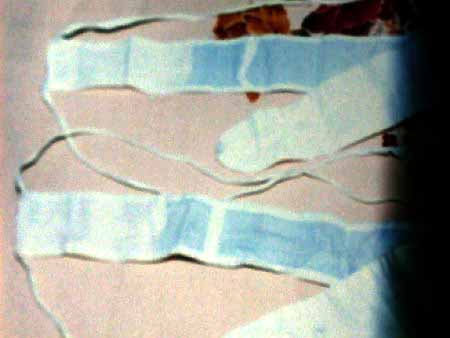|


|


Chinese menstrual belt and
pad, 2000,
with a correction in 2011
A Chinese woman sent me the following
e-mail that changes the impression the
male (below the next top e-mail) gave of
Chinese menstrual practices.
In fact,
it is rare for women to use belt pad
instead of stick-in pad, as
it is rare for Asian women to use
tampons. I guess the items the man
sent you were vintage. When you
go to a supermarket in China, you'll
be amazed for the variety of pads, but
there are always no tampons on the
stack!
Western brands like Whisper and Kotex
are very popular in China.
I am a Chinese living in Hong Kong.
(November
2011)
She
actually wrote about the belts and pads here.
Latinas also
much prefer pads over tampons.
An male e-mailer from China kindly
sent (November 2000) unsolicited
this photo to the museum, saying it
showed menstrual pad belts
- I assume the rectangular
blue-and-white strips attached
to the narrow waistbands -
and pads,
probably the slightly
wider rounded-end object at
the right in the middle. I've
asked the e-mailer for more
information,
including if the pad is washable or
disposable.
It looks like the Japanese uma,
"pony"
or "horse," a homemade pad and belt
used by the Japanese for hundreds
of years. I suspect the Chinese have
used something similar for centuries.
China influenced Japan in many ways -
Buddhism arrived from China, and the
Japanese language uses kanji, Chinese
characters used with Japanese grammar
and pronunciation, something that
makes Japanese perhaps the most
difficult
major language to learn - and maybe
China gave Japan this kind of belt and
pad, although there really aren't many
different ways to make a menstrual
pad belt.
See more
- and better photographed - Chinese
belts and pads, from 2000 and 2005.
|
 |
The two belts
are the rectangular
objects
attached to the string-like bands,
probably the waist bands.
The two white and basically vertical
bands in the blue area of the pads
might be a band to hold the pad in
place.
The pad
is the wider,
almost completely white object with
the rounded end, part of which you
see
at the right side of the picture.
|
|
© 2000 Harry Finley. It is
illegal to reproduce or distribute any
of the work on this Web site in any
manner or medium without written
permission
of the author. Please report suspected
violations to [email protected]
|
|




